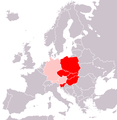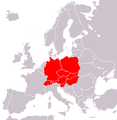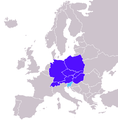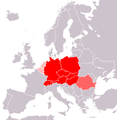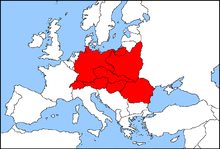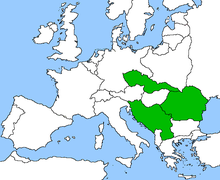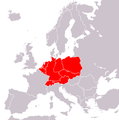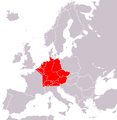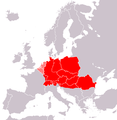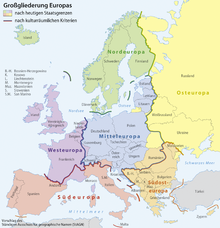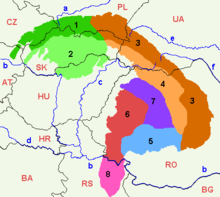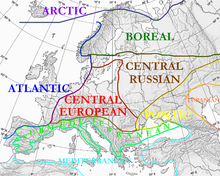- Central Europe
-
Central Europe or alternatively Middle Europe is a region of the European continent lying between the variously defined areas of Eastern and Western Europe. The term and widespread interest in the region itself came back into fashion[1] by the end of the Cold War, which had divided Europe politically into East and West, splitting Central Europe in half.[2][3]
The concept of Central Europe, and that of a common identity, is somewhat elusive.[4][5][6] However, scholars assert that a distinct "Central European culture, as controversial and debated the notion may be, exists."[7][8] It is based on "similarities emanating from historical, social and cultural characteristics",[7][9] and it is identified as having been "one of the world's richest sources of creative talent" between the 17th and 20th centuries.[10] Cross Currents: A Yearbook of Central European Culture characterizes Central Europe "as an abandoned West or a place where East and West collide".[11] Germany's Constant Committee for Geographical Names defines Central Europe both as a distinct cultural area and a political region.[12][13] George Schöpflin and others argue that Central Europe is defined by being "a part of Western Christianity",[14] while Samuel P. Huntington places the region firmly within Western culture.[15]
From the 2000's on, Central Europe is going through a phase of "strategic awakening",[16] with initiatives like the CEI, Centrope or V4. While the region's economy shows high disparities with regard to income,[17] all Central European countries are listed by the Human Development Index as "very high development" countries.[18]
Contents
Regional data
- Area : 1.036.370 km2 (2010)

- Population: (calculated data) 163.414.068 (July 2011)

- Population Density: (calculated data) 157.67/km2 (2011)

- GDP (PPP) per capita : USD$35.739 (2010)

- GDP (nominal) per capita : USSD$41.415 (2010)

- Life expectancy: (calculated data) 78.31 year (2011)

- Unemployment rate : 7.2% (2010)

- Fertility rate : 1.38 births/woman (2010)

- Human Development Index : 0.867 (2011) (very high)

Countries in descending order:
 Liechtenstein: 0.905 (8.)
Liechtenstein: 0.905 (8.) Germany: 0.905 (9.)
Germany: 0.905 (9.) Switzerland: 0.903 (11.)
Switzerland: 0.903 (11.) Austria: 0.885 (19.)
Austria: 0.885 (19.) Slovenia: 0.884 (21.)
Slovenia: 0.884 (21.) Czech Republic: 0.865 (27.)
Czech Republic: 0.865 (27.) Slovakia: 0.834 (35.)
Slovakia: 0.834 (35.) Hungary: 0.816 (38.)
Hungary: 0.816 (38.) Poland: 0.813 (39.)
Poland: 0.813 (39.)
States
The comprehension of the concept of Central Europe is an ongoing source of controversy,[19] though the Visegrád Group constituents are generally included as de facto C.E. countries.[20] According to the majority of sources (see section Current views on Central Europe for some) the region includes:
Some sources also add neighbouring countries (for historical, geographical and/or cultural reasons):
 Croatia
Croatia Romania (Transylvania and Bukovina, occasionally the entire country)
Romania (Transylvania and Bukovina, occasionally the entire country) Serbia[21][22] (Vojvodina, Mačva, northern Belgrade regions[23] historically also Sandžak-Raška[24] and at various times Central Serbia[25][26])
Serbia[21][22] (Vojvodina, Mačva, northern Belgrade regions[23] historically also Sandžak-Raška[24] and at various times Central Serbia[25][26])
The Baltic states, usually associated with Northern Europe, have been considered part of Central Europe in the German tradition, as were smaller parts of the following states:
 Ukraine (Western Ukraine)
Ukraine (Western Ukraine) Belarus (Western Belarus)
Belarus (Western Belarus) Russia (Kaliningrad Oblast)
Russia (Kaliningrad Oblast) France (Alsace and portions of Lorraine)
France (Alsace and portions of Lorraine) Italy (South Tyrol, Trentino, Trieste and Gorizia, Friuli, occasionally all of Northern Italy)
Italy (South Tyrol, Trentino, Trieste and Gorizia, Friuli, occasionally all of Northern Italy)
Current views on Central Europe
Rather than a physical entity, Central Europe is a concept of shared history which contrasts with that of the surrounding regions. The issue how to name and define the Central European region is subject to debates. Very often, the definition depends on nationality and historical perspective of its author.
Main propositions, gathered by Jerzy Kłoczowski, include:[27]
- West-Central and East-Central Europe – this conception, presented in 1950,[28] distinguished two regions in Central Europe: German West-Centre, with imperial tradition of the Reich, and the East-Centre covered by variety of nations from Finland to Greece, placed between great empires of Scandinavia, Germany, Italy and the Soviet Union
- Central Europe as the area of cultural heritage of the Polish-Lithuanian Commonwealth – Ukrainian, Belarusian and Lithuanian historians, in cooperation (since 1990) with Polish historians, insist on the importance of the notion
- Central Europe as a region connected to the Western civilisation for a very long time, including countries like the Polish-Lithuanian Commonwealth, Holy Roman Empire, later German Empire and the Habsburg Monarchy, the Kingdom of Hungary and Bohemia. Central Europe understood in this way borders on Russia and the South-Eastern Europe, but the exact frontier of the region is difficult to determine.
- Central Europe as the area of cultural heritage of the Habsburg Empire – a concept which is popular in the region of Danube River
- A concept underlining the links connecting Ukraine and Belarus with Russia and treating the Russian Empire together with the whole Slavic Orthodox population as one entity – this position is taken by the Russian historiography
- A concept putting an accent on the links with the West, especially from the 19th century and the grand period of liberation and formation of Nation-states – this idea is represented by in the South-Eastern states, which prefer the enlarged concept of the “East Centre” expressing their links with the Western culture
According to Ronald Tiersky, the 1991 summit held in Visegrád, Hungary and attended by the Polish, Hungarian and Czechoslovak presidents was hailed at the time as a major breakthrough in Central European cooperation, but the Visegrád Group became a vehicle for coordinating Central Europe's road to the European Union, while development of closer ties within the region languished.[29]
Peter J. Katzenstein described Central Europe as a way station in a Europeanization process that marks the transformation process of the Visegrád Group countries in different, though comparable ways.[30] According to him in Germany's contemporary public discourse "Central European identity" refers to the civilizational divide between Roman Catholicism and Eastern Orthodoxy.[30] He says there's no precise, uncontestable way to decide whether the Baltic states, Serbia, Croatia, Slovenia, Romania, and Bulgaria are parts of Central Europe or not.[31]
Lonnie R. Johnson points out criteria to distinguish Central Europe from Western, Eastern and Southeast Europe:[32]
- one criterion for defining Central Europe is the frontiers of medieval empires and kingdoms that largely correspond to the religious frontiers between the Roman Catholic West and the Orthodox East.[33] The pagans of Central Europe were converted to Roman Catholicism while in Southeastern and Eastern Europe they were brought in the fold of the Eastern Orthodox Church.[33]
- Multinational empires were a characteristic of Central Europe.[34] Hungary and Poland, small and medium-size states today, were empires during their early histories.[34] The historical Kingdom of Hungary was until 1918 three times larger than Hungary is today,[34] while Poland was the largest state in Europe in the sixteenth century.[34] Both these kingdoms housed a wide variety of different peoples.[34]
- as a mode of self-perception, despite the debated nature of the concept Central Europeans generally agree on which peoples are to be excluded from this club: for example Serbs, Bulgarians, Romanians and Russians.[35]
He also thinks that Central Europe is a dynamical historical concept, not a static spatial one. For example, Lithuania, a fair share of Belarus and western Ukraine are in Eastern Europe today, but 250 years ago they were in Poland.[34]
Johnson's study on Central Europe received acclaim and positive reviews[36][37] in the scientific community.The Columbia Encyclopedia defines Central Europe as: Germany, Switzerland, Liechtenstein, Austria, Poland, the Czech Republic, Slovakia, and Hungary.[38] The World Factbook[39] Encyclopedia Britannica and Brockhaus Enzyklopädie use the same definition adding Slovenia too. Encarta Encyclopedia does not clearly define the region, but places the same countries into Central Europe in its individual articles on countries, adding Slovenia in "south central Europe".[40]
The German Encyclopaedia Meyers grosses Taschenlexikon (English: Meyers Big Pocket Encyclopedia), 1999, defines Central Europe as the central part of Europe with no precise borders to the East and West. The term is mostly used to denominate the territory between the Schelde to Vistula and from the Danube to the Moravian Gate. Usually the countries considered to be Central European are Germany, Switzerland, Austria, Poland, the Czech Republic, Slovakia, Hungary, in the broader sense Romania too, occasionally also the Netherlands, Belgium and Luxembourg.
-
Central Europe according to Peter J. Katzenstein (1997)
countries for which there's no precise, uncontestable way to decide whether they are parts of Central Europe or not[31] -
According to The Economist and Ronald Tiersky a strict definition of Central Europe means the Visegrád Group[20][29]
-
Map of Central Europe, according to Lonnie R. Johnson (1996)[41]Easternmost Western European countries considered to be Central European only in the broader sense of the term.
-
Central Europe according to The World Factbook (2009)[39] Encyclopedia Britannica and Brockhaus Enzyklopädie (1998)
-
Central Europe according to Columbia Encyclopedia (2009) and BBC[38]
-
Central European countries in Encarta Encyclopedia (2009)[40]
Central European countriesSlovenia in "south central Europe"
History of the concept
Middle Ages
As elements of unity for Western and Central Europe were considered the Roman Catholicism and Latin. Eastern Europe that remained Orthodox Christian, was the area of Byzantine cultural influence, and after the schism will develop cultural unity and protection against the Catholic and Protestant (Western) world, within the framework of Slavonic language and the Cyrillic alphabet.[42]
In 1335 under the rule of the King Charles I of Hungary, the castle of Visegrád, the seat of the Hungarian monarchs was the scene of the royal summit of the Kings of Poland, Bohemia and Hungary.[43] They agreed to cooperate closely in the field of politics and commerce, inspiring their late successors to launch a successful Central European initiative.[43]
Before World War I
A view of Central Europe dating from the time before the First World War (1902):[44] Central European countries and regions: Germany and Austria-Hungary (without Bosnia-Herzegovina and Dalmatia)Regions located at the transition between Central Europe and Eastern Europe: Romania
Central European countries and regions: Germany and Austria-Hungary (without Bosnia-Herzegovina and Dalmatia)Regions located at the transition between Central Europe and Eastern Europe: RomaniaThe concept of Central Europe was already known at the beginning of the 19th century,[45] but its real life began in the 20th century and immediately became an object of intensive interest. However, the very first concept mixed science, politics and economy – it was strictly connected with intensively growing German economy and its aspirations to dominate a part of European continent called Mitteleuropa. The German term denoting Central Europe was so fashionable that other languages started referring to it when indicating territories from Rhine to Vistula, or even Dnieper, and from the Baltic Sea to the Balkans.[46] An example of that-time vision of Central Europe may be seen in J. Partsch’s book of 1903.[47]
On 21 January 1904 – Mitteleuropäischer Wirtschaftsverein (Central European Economic Association) was established in Berlin with economic integration of Germany and Austria–Hungary (with eventual extension to Switzerland, Belgium and the Netherlands) as its main aim. Another time, the term Central Europe became connected to the German plans of political, economic and cultural domination. The “bible” of the concept was Friedrich Naumann’s book Mitteleuropa[48] in which he called for an economic federation to be established after the war. Naumann's idea was that the federation would have at its center Germany and the Austro-Hungarian Empire but would also include all European nations outside the Anglo-French alliance, on one side, and Russia, on the other.[49] The concept failed after the German defeat in the World War I and the dissolution of Austria–Hungary. The revival of the idea may be observed during the Hitler era.
Interwar period
According to Emmanuel de Martonne, in 1927 the Central European countries included: Germany, Switzerland, Austria, Poland, Czechoslovakia, Hungary and Romania. Italy and Yugoslavia are not considered by the author to be Central European because they are located mostly outside Central Europe. The author use both Human and Physical Geographical features to define Central Europe.[50]
The interwar period (1918–1939) brought new geopolitical system and economic and political problems, and the concept of Central Europe took a different character. The centre of interest was moved to its eastern part – the countries that have reappeared on the map of Europe: Poland, Hungary and Czechoslovakia. Central Europe ceased to be the area of German aspiration to lead or dominate and became a territory of various integration movements aiming at resolving political, economic and national problems of "new" states, being a way to face German and Soviet pressures. However, the conflict of interests was too big and neither Little Entente nor Międzymorze ideas succeeded.
The interwar period brought new elements to the concept of Central Europe. Before World War I, it embraced mainly German states (Germany, Austria), non-German territories being an area of intended German penetration and domination – German leadership position was to be the natural result of economic dominance.[45] After the war, the Eastern part of Central Europe was placed at the centre of the concept. At that time the scientists took interest in the idea: the International Historical Congress in Brussels in 1923 was committed to Central Europe, and the 1933 Congress continued the discussions.
Magda Adam, in the Versailles System and Central Europe, published in the Oxford journals: "Today we know that the bane of Central Europe was the Little Entente, military alliance of Czechoslovakia, Romania and Kingdom of Serbs, Croats and Slovenes (later Yugoslavia), created in 1921 not for Central Europe's cooperation nor to fight German expansion, but in a wrong perceived notion that a completely powerless Hungary must be kept down".[51]
The avant-garde movements of Central Europe were an essential part of modernism’s evolution, reaching its peak throughout the continent during the 1920s. The Sourcebook of Central European avantgards (Los Angeles County Museum of Art) contains primary documents of the avant-gardes in Austria, Czechoslovakia, Germany, Hungary, Poland, Romania, and Yugoslavia from 1910 to 1930.[52] The manifestos and magazines of Western European radical art circles are well known to Western scholars and are being taught at primary universities of their kind in the western world.
Central Europe behind the Iron Curtain
Following World War II, large parts of Europe that were culturally and historically Western became part of the Eastern bloc. Czech author Milan Kundera (emigrant to France) thus wrote in 1984 about the "Tragedy of Central Europe" in the New York Review of Books.[53] Consequently, the English term Central Europe was increasingly applied only to the westernmost former Warsaw Pact countries (East Germany, Poland, Czechoslovakia, Hungary) to specify them as communist states that were culturally tied to Western Europe.[54] This usage continued after the end of the Warsaw Pact when these countries started to undergo transition.
The post-World War II period brought blocking of the research on Central Europe in the Eastern Bloc countries, as its every result proved the dissimilarity of Central Europe, which was inconsistent with the Stalinist doctrine. On the other hand, the topic became popular in Western Europe and the United States, much of the research being carried out by immigrants from Central Europe.[55] At the end of the communism, publicists and historians in Central Europe, especially anti-communist opposition, came back to their research.[56]
According to Meyers Enzyklopädisches Lexikon,[57] Central Europe is a part of Europe composed by the surface of the Netherlands, Belgium, Luxembourg, Germany, Poland, Switzerland, Austria, Czechoslovakia, Hungary and Romania, northern marginal regions of Italy and Yugoslavia (northern states- Slovenia, Croatia and Serbia) as well as northeastern France. Sometimes,[citation needed] the Netherlands, Belgium and Luxembourg are not regarded as Central European.
-
Central Europe, as defined by E. Schenk (1950)[58]
Mitteleuropa, the German term
The German term Mitteleuropa (or alternatively its literal translation into English, Middle Europe[59]) is an ambiguous German concept.[59] It is sometimes used in English to refer to an area somewhat larger than most conceptions of 'Central Europe'; it refers to territories under German(ic) cultural hegemony until World War I (encompassing Austria–Hungary and Germany in their pre-war formations but usually excluding the Baltic countries north of East Prussia).[citation needed] According to Fritz Fischer Mitteleuropa was a scheme in the era of the Reich of 1871–1918 by which the old imperial elites had allegedly sought to build a system of German economic, military and political domination from the northern seas to the Near East and from the Low Countries through the steppes of Russia to the Caucasus.[60] Professor Fritz Epstein argued the threat of a Slavic "Drang nach Westen" (Western expansion) had been a major factor in the emergence of a Mitteleuropa ideology before the Reich of 1871 ever came into being.[61]
In Germany the connotation is also sometimes linked to the pre-war German provinces east of the Oder-Neisse line which were lost as the result of World War II, annexed by People's Republic of Poland and the Soviet Union, and ethnically cleansed of Germans by communist authorities and forces (see expulsion of Germans after World War II) due to Yalta Conference and Potsdam Conference decisions. In this view Bohemia and Moravia, with its dual Western Slavic and Germanic heritage, combined with the historic element of the "Sudetenland", is a core region illustrating the problems and features of the entire Central European region.
The term Mitteleuropa conjures up negative historical associations, although the Germans have not played an exclusively negative role in the region.[35] Most Central European Jews embraced the enlightened German humanistic culture of the 19th century.[62] German-speaking Jews from turn-of-the-century Vienna, Budapest and Prague became representatives of what many consider to be Central European culture at its best, though the Nazi version of "Mitteleuropa" destroyed this kind of culture.[62] Some German speakers are sensitive enough to the pejorative connotations of the term Mitteleuropa to use Zentraleuropa instead.[59] Adolf Hitler was obsessed by the idea of Lebensraum and many non-German Central Europeans identify Mitteleuropa with the instruments he employed to acquire it: war, deportations, genocide.[63]Physical geography
Between the Alps and the Baltics
Geography strongly defines Central Europe's borders with its neighbouring regions to the North and South, namely Northern Europe (or Scandinavia) across the Baltic Sea, the Apennine peninsula (or Italy) across the Alps and the Balkan peninsula across the Soča-Krka-Sava-Danube line. The borders to Western Europe and Eastern Europe are geographically less defined and for this reason the cultural and historical boundaries migrate more easily West-East than South-North. The Rhine river which runs South-North through Western Germany is an exception.
Pannonian Plain and Carpathian Mountains
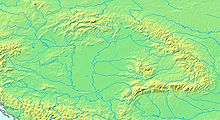 The Pannonian Plain, between the Alps (west), the Carpathians (north and east), and the Sava/Danube (south)
The Pannonian Plain, between the Alps (west), the Carpathians (north and east), and the Sava/Danube (south)
Geographically speaking, the Carpathian mountains divide the European Plain into two sections: the Central Europe's Pannonian Plain in the west,[64] and the East European Plain, which lie eastward of the Carpathians. Southwards, the Pannonian Plain is bounded by the rivers Sava and Danube- and their respective floodplains.[65] This area mostly corresponds to the borders of the former Austria-Hungary. The Pannonian Plain extends into the following countries: Austria, Bosnia and Herzegovina, Croatia, Hungary, Romania, Serbia, Slovakia, Slovenia and Ukraine.
Dinaric Alps
As southeastern division of the Eastern Alps,[66] the Dinaric Alps extend for 650 kilometres along the coast of the Adriatic Sea (northwest-southeast), from the Julian Alps in the northwest down to the Šar-Korab massif, where the mountain direction changes to north-south. According to the Freie Universitaet Berlin[67] this mountain chain is classified as South Central European.
Flora
The Central European Flora region stretches from Central France (Massif Central) to Central Romania (Carpathians) and Southern Scandinavia.[68]
See also
- Central European Initiative
- Central European University
- Central European Time (CET)
- East-Central Europe
- Geographical centre of Europe
- Life zones of central Europe
- Międzymorze (Intermarum)
- Mitteleuropa
References
- ^ "Central Europe — The future of the Visegrad group". The Economist. 2005-04-14. http://www.economist.com/displayStory.cfm?Story_ID=E1_PRSTNSV. Retrieved 2009-03-07.
- ^ "Regions, Regionalism, Eastern Europe by Steven Cassedy". New Dictionary of the History of Ideas, Charles Scribner's Sons. 2005. http://science.jrank.org/pages/11016/Regions-Regionalism-Eastern-Europe-Future-Eastern-Europe.html. Retrieved 2010-01-31.
- ^ Lecture 14: The Origins of the Cold War. Historyguide.org. Retrieved on 2011-10-29.
- ^ Agh 1998, pp. 2–8
- ^ "Central European Identity in Politics — Jiří Pehe" (in Czech). Conference on Central European Identity, Central European Foundation, Bratislava. 2002. http://www.pehe.cz/prednasky/2002/central-european-identity-in-politics. Retrieved 2010-01-31.
- ^ "Europe of Cultures: Cultural Identity of Central Europe". Europe House Zagreb, Culturelink Network/IRMO. 1996-11-24. http://www.culturelink.org/conf/cultid01/index.html. Retrieved 2010-01-31.
- ^ a b Comparative Central European culture. Purdue University Press. 2002. ISBN 9781557532404. http://books.google.com/books?id=k9IwimrMIQgC. Retrieved 2010-01-31.
- ^ "An Introduction to Central Europe: History, Culture, and Politics – Preparatory Course for Study Abroad Undergraduate Students at CEU". Central European University. Budapest. Fall 2006. http://ceu.bard.edu/academic/documents/MandatorycourseonCentralEurope.pdf.
- ^ Ben Koschalka – content, Monika Lasota – design and coding. "To Be (or Not To Be) Central European: 20th Century Central and Eastern European Literature". Centre for European Studies of the Jagiellonian University. http://www.ces.uj.edu.pl/fiut/culture.htm. Retrieved 2010-01-31.
- ^ "Ten Untaught Lessons about Central Europe-Charles Ingrao". HABSBURG Occasional Papers, No. 1.. 1996. http://www.h-net.org/~habsweb/occasionalpapers/untaughtlessons.html. Retrieved 2010-01-31.
- ^ "Introduction to the electronic version of Cross Currents". Scholarly Publishing Office of the University of Michigan Library. http://quod.lib.umich.edu/c/crossc/intro.html. Retrieved 2010-01-31.
- ^ "StAGN-Empfehlung zur Großgliederung Europas". StAGN.de. http://141.74.33.52/stagn/JordanEuropaRegional/tabid/71/Default.aspx. Retrieved 2011-01-31.
- ^ "A Subdivision of Europe into Larger Regions by Cultural Criteria". http://www.docstoc.com/docs/53115069/A-Subdivision-of-Europe-into-Larger-Regions-by-Cultural. Retrieved 2011-01-15.
- ^ History of the literary cultures of East-Central Europe: junctures and disjunctures in the 19th and 20th centuries, Volume 2 [1]
- ^ When identity becomes an alibi (Institut Ramon Llull) [www.llull.cat/rec_transfer/webt1/transfer01_essa05.pdf]
- ^ "The Mice that Roared: Central Europe Is Reshaping Global Politics". Spiegel.de. 26 February 2006. http://www.spiegel.de/international/europe/0,1518,610019,00.html. Retrieved 2010-01-31.
- ^ "Which regions are covered?". European Regional Development Fund. http://www.central2013.eu/about-central/regions/. Retrieved 2010-01-31.
- ^ 2010 Human Development Index. (PDF) . Retrieved on 2011-10-29.
- ^ "For the Record – The Washington Post – HighBeam Research". Highbeam.com. 1990-05-03. http://www.highbeam.com/doc/1P2-1124570.html?refid=gg_x_02. Retrieved 2010-01-31.
- ^ a b "From Visegrad to Mitteleuropa". The Economist. 14 April 2005. http://www.economist.com/node/3871275?Story_ID=E1_PRSTNSV.
- ^ File:Serbia-ahu2.jpg. Part of the map Serbia under Habsburg rule
- ^ File:Srbah2.jpg part of the map Carte de l'Empire autrichien au XVIIIe siècle jusqu'au troisième partage de la Pologne (1795)
- ^ "Vlada Autonomne Pokrajine Vojvodine – Index". Vojvodina.gov.rs. 2010-01-27. http://www.vojvodina.gov.rs/index.php?option=com_content&task=view&id=174&Itemid=83. Retrieved 2010-01-31.
- ^ The Austrian Occupation of Novibazar, 1878–1909. Mtholyoke.edu. Retrieved on 2011-10-29.
- ^ http://www.conflicts.rem33.com/images/Ungarn/OESTEREICH%20ENTWICKLUNG.jpg
- ^ http://terkepek.adatbank.transindex.ro/kepek/netre/51.gif
- ^ Jerzy Kłoczowski, Actualité des grandes traditions de la cohabitation et du dialogue des cultures en Europe du Centre-Est, in: L'héritage historique de la Res Publica de Plusieurs Nations, Lublin 2004, pp. 29–30 ISBN 8385854827
- ^ Oskar Halecki, The Limits and Divisions of European History, Sheed & Ward: London and New York 1950, chapter VII
- ^ a b Tiersky, p. 472
- ^ a b c Katzenstein, p. 6
- ^ a b Katzenstein, p. 4
- ^ Lonnie R. Johnson "Central Europe: enemies, neighbors, friends", Oxford University Press, 1996 ISBN 0195386647
- ^ a b Johnson, p.4
- ^ a b c d e f Johnson, p. 4
- ^ a b Johnson, p. 6
- ^ Legvold, Robert (May/June 1997). "Central Europe: Enemies, Neighbors, Friends". Foreign Affairs. Council on Foreign Relations. http://www.foreignaffairs.com/articles/52992/robert-legvold/central-europe-enemies-neighbors-friends. Retrieved 2009-05-20.
- ^ "Selected as "Editor's Choice" of the History Book Club". Oxford University Press. http://www.oup.com/us/catalog/general/subject/Politics/InternationalStudies/?view=usa&ci=9780195148251&view=usa. Retrieved 2009-05-20.
- ^ a b "Europe". Columbia University Press. 2009.
- ^ a b "The World Factbook: Field listing – Location". The World Factbook. Central Intelligence Agency. 2009. https://www.cia.gov/library/publications/the-world-factbook/fields/2144.html. Retrieved 2009-05-03.
- ^ a b "Slovenia". Encarta. Archived from the original on 2009-10-31. http://www.webcitation.org/5kwafS3Ax. Retrieved 2009-05-01.
- ^ Johnson, pp. 11–12
- ^ The shape of Europe. The spirit of unity through culture in the eve of Modern Europe.
- ^ a b Halman, Loek; Wilhelmus Antonius Arts (2004). "European values at the turn of the millennium". Brill Publishers. p. 120. ISBN 9789004139817.
- ^ Source: Geographisches Handbuch zu Andrees Handatlas, vierte Auflage, Bielefeld und Leipzig, Velhagen und Klasing, 1902.
- ^ a b ""Mitteleuropa" is a multi-facetted concept and difficult to handle" (PDF). http://www.essex.ac.uk/ecpr/events/graduateconference/barcelona/papers/681.pdf. Retrieved 2010-01-31.
- ^ A. Podraza, Europa Środkowa jako region historyczny, 17th Congress of Polish Historians, Jagiellonian University 2004
- ^ Joseph Franz Maria Partsch, Clementina Black, Halford John Mackinder, Central Europe, New York 1903
- ^ F. Naumann, Mitteleuropa, Berlin: Reimer, 1915
- ^ "Regions and Eastern Europe Regionalism – Central Versus Eastern Europe". Science.jrank.org. http://science.jrank.org/pages/11015/Regions-Regionalism-Eastern-Europe-Central-versus-Eastern-Europe.html. Retrieved 2010-01-31.
- ^ [2], [3] and [4]; Géographie universelle (1927), edited by Paul Vidal de la Blache and Lucien Gallois)
- ^ a b Deak, I. (2006). "The Versailles System and Central Europe". The English Historical Review CXXI (490): 338. doi:10.1093/ehr/cej100.
- ^ "Between Worlds – The MIT Press". Mitpress.mit.edu. http://mitpress.mit.edu/catalog/item/default.asp?ttype=2&tid=8958. Retrieved 2010-01-31.
- ^ "Kundera's article in pdf format". http://www.euroculture.upol.cz/dokumenty/sylaby/Kundera_Tragedy_(18).pdf.
- ^ "Central versus Eastern Europe". http://science.jrank.org/pages/11015/Regions-Regionalism-Eastern-Europe-Central-versus-Eastern-Europe.html.
- ^ One of the main representatives was Oscar Halecki and his book The limits and divisions of European history, London and New York 1950
- ^ A. Podraza, Europa Środkowa jako region historyczny, 17th Congress of Polish Historians, Jagiellonian University 2004
- ^ Band 16, Bibliographisches Institut Mannheim/Wien/Zürich, Lexikon Verlag 1980
- ^ Erich Schenk, Mitteleuropa. Düsseldorf, 1950
- ^ a b c Johnson, p. 165
- ^ Hayes, p. 16
- ^ Hayes, p. 17
- ^ a b Johnson, p. 7
- ^ Johnson, p. 170
- ^ "Dark Series Research by Christine Feehan". Christinefeehan.com. 2008-11-13. http://www.christinefeehan.com/dark_series/research.php. Retrieved 2010-01-31.
- ^ Danube Facts and Figures. Bosnia and Herzegovina (April 2007) (PDF file)
- ^ Encyclopædia Britannica. "Dinaric Alps (mountains, Europe)". http://www.britannica.com/EBchecked/topic/163795/Dinaric-Alps. Retrieved 2010-01-31.
- ^ Juliane Dittrich. "Die Alpen – Höhenstufen und Vegetation – Hauptseminararbeit". GRIN. http://www.grin.com/e-book/37159/die-alpen-hoehenstufen-und-vegetation. Retrieved 2010-01-31.
- ^ Wolfgang Frey and Rainer Lösch; Lehrbuch der Geobotanik. Pflanze und Vegetation in Raum und Zeit. Elsevier, Spektrum Akademischer Verlag, München 2004 ISBN 3827411939
Bibliography
- Ágh, Attila (1998). The politics of Central Europe. SAGE. ISBN 076195032X.
- Hayes, Bascom Barry (1994). Bismarck and Mitteleuropa. Fairleigh Dickinson University Press. ISBN 9780838635124.
- Johnson, Lonnie R. (1996). Central Europe: enemies, neighbors, friends. Oxford University Press. ISBN 9780195100716.
- Katzenstein, Peter J. (1997). Mitteleuropa: Between Europe and Germany. Berghahn Books. ISBN 9781571811240.
- O. Benson, Forgacs (2002). Between Worlds. A Sourcebook of Central European Avant-Gardes, 1910–1930. MIT Press. ISBN 978-0-262-02530-0.
- Tiersky, Ronald (2004). Europe today. Rowman & Littlefield. ISBN 9780742528055.
Further reading
- Jacques Rupnik, "In Search of Central Europe: Ten Years Later", in Gardner, Hall, with Schaeffer, Elinore & Kobtzeff, Oleg, (ed.), Central and South-central Europe in Transition, Westport, Connecticut: Praeger, 2000 (translated form French by Oleg Kobtzeff)
- Article 'Mapping Central Europe' in hidden europe, 5, pp. 14–15 (November 2005)
- A journal in three languages (English, German, French) dealing with the region: http://www.ece.ceu.hu
External links
- Central Europe travel guide from Wikitravel
- Halecki, Oscar. "BORDERLANDS OF WESTERN CIVILIZATION A History of East Central Europe" (PDF). Oscar Halecki. http://hungarian-history.hu/lib/halecki/halecki.pdf. Retrieved 2010-08-08.
- Map of Europe
- Maps of Europe and European countries
Regions of the world 
Africa Northern · Sub-Saharan (Central · Southern · Western · Eastern) 
Oceania Australasia (Australia) · Melanesia · Micronesia · Polynesia 
America North (Northern • Middle • Central • Caribbean) · South (Southern • Northern • Western) · Anglo · Latin 
Polar Arctic · Antarctic 
Asia Central · Eastern (Northeastern) · Northern · Southeastern · Southern (Indian subcontinent) · Western (Middle East) 
Oceans World · Arctic · Atlantic · Indian · Pacific · Southern 
Europe Central · Eastern · Northern · Southeastern · Southern · Western 
Seas List of seas Related Continents of the world · List of seas · Physical EarthEurope Culture Art (Architecture · Capital of Culture · Classical music · Cinema (Film festivals) · Painting · Sculpture) · Cuisine · Etiquette · Literature · Languages (Endangered) · Philosophy · Religion (Christianity · Islam · Judaism) · Sport · Symbols · Universities (Bologna Process · Erasmus)Demographics Ageing · Education · Ethnic groups (Genetic history) · Immigration · Life expectancy · Retirement · PopulationEconomy Geography Sovereign states and dependent territories · Area and population · Cities · Villages · Geology · Islands · Rivers · Lakes · Mountains · Extreme pointsHistory Prehistory · Classical antiquity · Late Antiquity · Middle Ages · Early modernity · Military · Predecessor states · Dates of achieving sovereigntyPolitics International organisations · Integration · CIS · CoE · CSTO · GUAM · NATO · OSCE (statistics) · Post-Soviet · Transatlantic · EurosphereEuropean Union Members (future) · Politics · Visa policy · ENP · Foreign relations · Economic relations (FTAs) · Economy · Eurozone · EEA · EUCU · Schengen · StatisticsOther Communications · Crisis situations and protests · Financial and social rankings · Internet users · Law · Maps · Press Freedom Index · TransportCategories: - Area : 1.036.370 km2 (2010)
Wikimedia Foundation. 2010.




